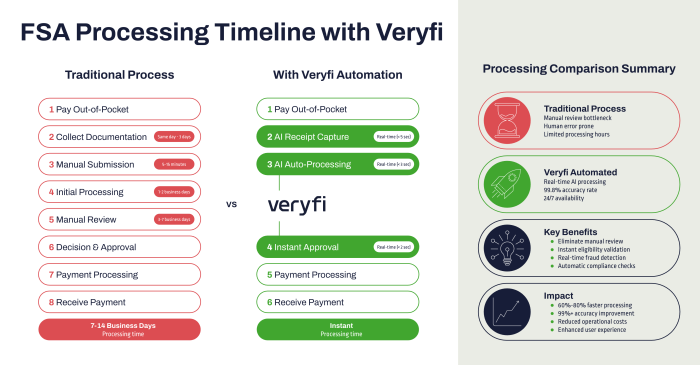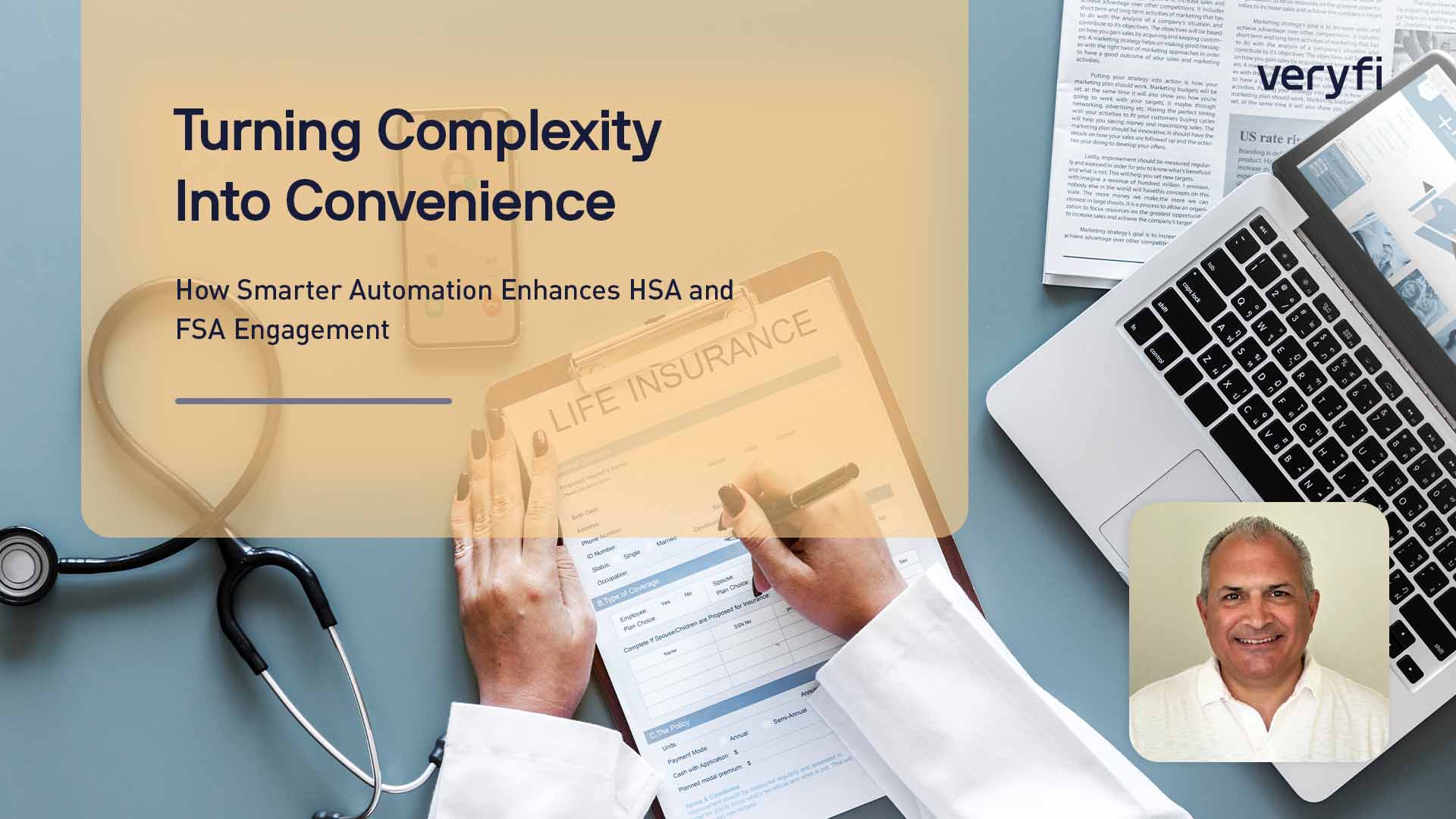Streamlining HSA and FSA Workflows with Intelligent Document Processing (IDP)
If you’ve ever found yourself digging through your inbox for a missing receipt, re-uploading the same PDF twice, or anxiously awaiting reimbursement before the deadline, you’re not alone. Despite their financial benefits, Health Savings Accounts (HSAs) and Flexible Spending Accounts (FSAs) often frustrate users due to clunky processes, vague documentation process requirements, and slow reimbursements.
Several factors influence how satisfying (or painful) your experience is:
- The quality of documentation from healthcare providers
- The technology platform used to manage claims
- The responsiveness of your benefits administrator
- And most critically — whether the process is automated or manual
When these systems are inefficient, the burden falls on families who rely on FSAs to bridge gaps in health coverage for sports injuries, dental and contact lens overages. As a parent, managing an active household of four, I’ve experienced firsthand how even simple reimbursement requests can become stressful and time-consuming, especially around year end deadlines.
That’s why automation, accuracy, and user experience matter more than ever. Let’s dive in.
What Are HSAs and FSAs? Health Savings Accounts (HSAs) and Flexible Spending Accounts (FSAs) are tax-advantaged financial accounts that allow individuals to save for qualified medical expenses. FSAs are typically employer-sponsored, while HSAs are available to individuals enrolled in high-deductible health plans (HDHPs). Both offer tax-free savings and withdrawals for eligible healthcare-related costs.
Rising Popularity and Market Growth: In recent years, HSAs and FSAs have seen widespread adoption. According to Devenir Research, a specialized research and advisory firm focused on the Health Savings Account (HSA) market, HSA assets reached nearly $147 billion across more than 39 million accounts by year-end 2024 — a 19% growth in assets and 5% in account count year-over-year.
Similarly, the FSA market has grown steadily, with 2024 total annual spending: estimated around $36 billion in FSA-funded expenses nationwide, driven by increasing healthcare costs and employer interest in offering tax-advantaged benefits.
Traditional players like Optum, WageWorks (now part of HealthEquity), HSA Bank and Fidelity dominate, while newer tech-forward platforms like Lively, Bend (now part of HSA), WEX Health, and Inspira Financial are driving innovation and competitive pressure.
Key Differences: FSA vs. HSA
| Workflow Steps | FSA | HSA |
| Fund Expiration | Use-it-or-lose-it annually | Rollover year to year |
| Contributions | Employee-only | Employee + employer |
| Substantiation | Required at transaction | Required for audit only |
| Audit Readiness | Managed by plan administrator | Account holder responsibility |
| Reimbursements | Typically within plan year | Can be indefinite |
| Tax Reporting | No IRS form | IRS Form 8889 required |
Stakeholder Ecosystem: Access to these accounts involves multiple stakeholders
- Employers offer FSAs and HSAs as part of benefits packages.
- Benefit administrators/providers partner with employers to manage accounts.
- Employees enroll through their employer or directly (in the case of HSAs).
- Integration partners and platforms facilitate connectivity, claims processing, and user experience.
Need for Differentiation in a Crowded Market: With increasing competition, providers must differentiate with
- Seamless user experiences
- Automation across claims and reimbursements
- Minimal manual intervention for users, employers, or providers
- Accurate, real-time processing
The Reimbursement Challenge: Both FSAs and HSAs require documentation for reimbursement and IRS compliance. This process can be time-consuming, error-prone, and frustrating when reliant on manual uploads or incomplete receipts. The reconciliation of expenses with plan eligibility rules demands precision and consistency.
Why Automation and Data Extraction matter: Automating this process reduces friction, drive efficiencies and ensures compliance
Intelligent Document Processing (IDP) with pretrained deterministic models enable:
- Mobile capture with on-device AI intelligence
- Precise data capture from unstructured documents with line-item detail
- Real-time document fraud detection
- Structured outputs for eligibility checks, reimbursement reconciliation and audit trails
Example Workflow: FSA + IDP enhances every step of the FSA journey:
- Enroll in Your FSA
- Sign up during open enrollment or after qualifying life events
- Annual funds available Day 1
- Pay for Eligible Expenses
- Use FSA card for covered services
- Some transactions auto-approved; most others require receipts
- Capture Receipts
- Preferred: mobile capture with blur detection and real-time feedback
- Alternate: Upload via portal or integrated APIs
- Fraud Detection
- Scan for duplicates, tampering, and ineligible items
- Color-coded flagging system (Green/Yellow/Red)
- Detection of AI Generated documents
- AI-Driven Data Extraction
- Merchant name, service date, totals, and line-item details
- Standardization & Enrichment
- Normalize data formats, match vendors, and apply rules
- Identify brand and category of each line on the receipt
- Reimbursement Workflow
- Upload out-of-pocket receipts or EOBs
- Auto-process through secure backend
- Reconcile against eligible product and service lists
- Funds disbursed via direct deposit or check
- Continuous Optimization
- Notifications for missing documents
- Rules updated regularly for compliance and fraud

Benefits of Embedding IDP
- Faster Time to Market: Day One Ready AI Models integrates quickly and scales reliably.
- Smarter Validation: Deterministic AI API endpoints ensure precise results from first scan and extraction, no human-in-the-loop required.
- Reliable & Compliant: Fully automated, SOC 2 Type II certified, GDPR, HIPAA compliant, built for regulatory standards.
- Differentiated UX: Accurate, seamless experiences increase user satisfaction and reduce support resources.
- Domain Expertise: Deep embedded fintech and healthcare knowledge; committed to innovation and client success.
- Mobile Lens SDK Advantages
- On-device AI improves photo quality with blur detection, lighting, and auto-flash
- Developer-friendly SDK integrates easily into iOS, Android, web, or PWAs
- Auto document detection and long receipt capture for optimal usability
Conclusion: Why IDP is the Better Approach building IDP solutions internally or relying on traditional OCR tools can’t meet the demands of modern HSA/FSA platforms. Multimodal document data extraction platform offers automation, compliance, and performance out of the box — purpose-built for regulated industry use cases. By embedding AI-driven document intelligence into FSA/HSA workflows, providers unlock speed, scalability, and a competitive edge in an increasingly dynamic market. The result is a more efficient operation that delivers a frictionless user experience—driving higher adoption, greater satisfaction, and long-term loyalty.
– Dave Pietropaolo
About: Dave is a go-to-market leader with over 20 years of experience delivering innovative solutions across the financial services and healthcare industries. He has partnered with many of the most recognized brands in the space and is passionate about simplifying complex workflows, driving automation, and improving both customer experience and financial outcomes.
Have questions? Book a call with Dave for expert guidance.
